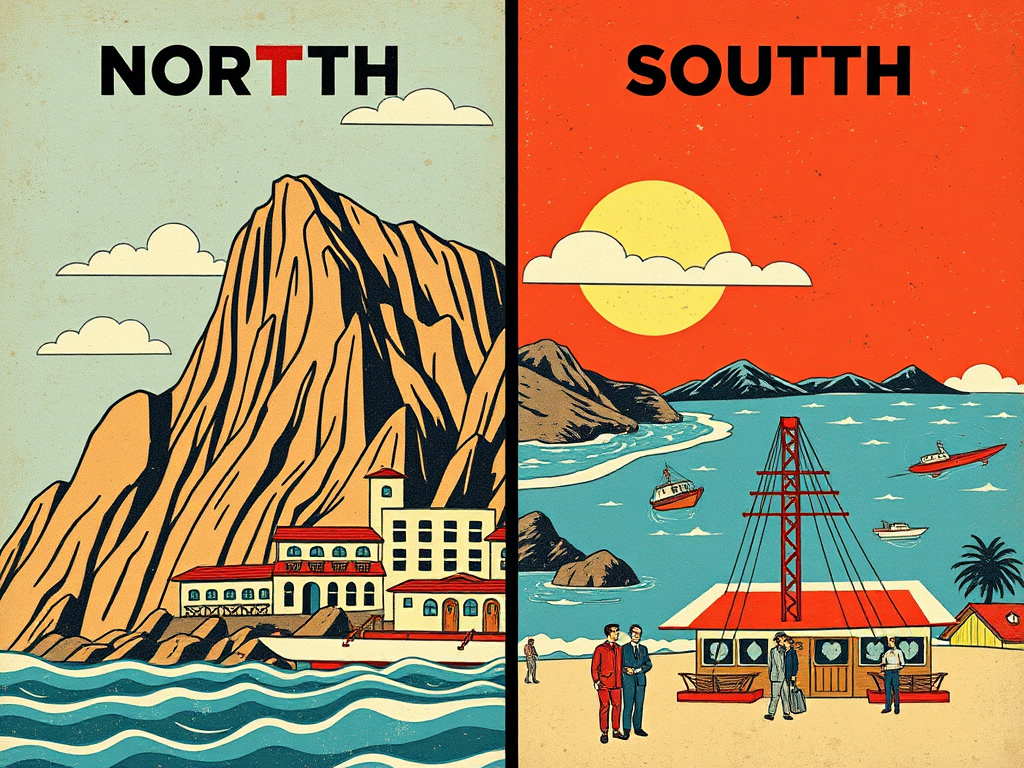
Crete North vs. South Coast: Choosing the Best Location for Your Investment
Reading time: 15 minutes
Table of Contents
- Introduction
- Overview of Crete’s Geography
- North Coast of Crete
- South Coast of Crete
- Comparative Analysis
- Investment Opportunities
- Economic Indicators
- Future Outlook
- Conclusion
- FAQs
Introduction
As investors and property seekers increasingly turn their attention to the Mediterranean, Crete emerges as a prime destination for those looking to capitalize on the region’s burgeoning real estate market. The island’s diverse landscape, rich history, and strategic location make it an attractive option for both short-term rentals and long-term investments. However, the decision between Crete’s north and south coasts can significantly impact the potential return on investment and overall satisfaction with a property purchase.
This comprehensive analysis will delve into the nuances of Crete’s coastal regions, examining economic indicators, tourism trends, and real estate market dynamics to provide a data-driven perspective on where to focus your investment efforts. Whether you’re considering a vacation home, a retirement property, or a pure investment play, understanding the distinctions between the north and south coasts is crucial for making an informed decision.
Overview of Crete’s Geography
Crete, the largest of the Greek islands, boasts a diverse topography that significantly influences its real estate landscape. The island stretches approximately 260 kilometers from east to west and varies between 12 to 60 kilometers from north to south. This elongated shape creates two distinct coastlines, each with its own character and appeal.
The central spine of the island is dominated by three mountain ranges: the White Mountains (Lefka Ori), Mount Ida (Psiloritis), and the Dikti Mountains. These geographical features not only create breathtaking vistas but also play a crucial role in determining climate patterns, accessibility, and development potential across different regions of the island.
North Coast of Crete
Infrastructure and Accessibility
The north coast of Crete is characterized by its well-developed infrastructure and ease of access. This region hosts the island’s major cities, including Heraklion, Chania, and Rethymno, as well as the primary airports and ports. The presence of the main highway running along the northern coast further enhances connectivity, making it an attractive option for those prioritizing convenience and urban amenities.
Tourism and Economic Activity
Historically, the north coast has been the epicenter of Crete’s tourism industry. The concentration of hotels, resorts, and tourist facilities along this stretch has created a robust ecosystem that supports a thriving seasonal economy. This established tourism infrastructure can be a double-edged sword for investors, offering potential for high rental yields during peak seasons but also facing increased competition and potential market saturation.
Real Estate Market Trends
The real estate market on the north coast tends to be more dynamic and liquid, with a higher volume of transactions and a broader range of property types available. Prices in popular areas like Chania and Heraklion have shown steady appreciation over the past decade, driven by both domestic and international demand. However, this also means that entry prices for prime properties can be significantly higher compared to less developed areas.
South Coast of Crete
Natural Beauty and Serenity
In contrast to the bustling north, Crete’s south coast is renowned for its unspoiled natural beauty, secluded beaches, and tranquil atmosphere. The region’s relative inaccessibility has preserved much of its authentic charm, making it increasingly attractive to those seeking a more laid-back lifestyle or a genuine Greek experience.
Development Potential
The south coast presents significant untapped potential for development. As the north coast approaches saturation in some areas, investors and developers are increasingly turning their attention southward. This shift could herald a period of growth and appreciation for property values in the region, particularly in areas that maintain a balance between development and natural preservation.
Niche Tourism Opportunities
While mass tourism is less prevalent on the south coast, the region is gaining popularity among eco-tourists, adventure seekers, and those interested in cultural experiences. This trend opens up opportunities for niche hospitality investments, such as boutique hotels, eco-lodges, and agritourism ventures, which could offer unique value propositions in an evolving tourism landscape.
Comparative Analysis
Investment Returns
When comparing potential returns on investment between the north and south coasts, several factors come into play:
- North Coast: Higher initial investment, potentially higher short-term rental yields due to established tourism infrastructure.
- South Coast: Lower entry prices, potential for higher long-term appreciation as the region develops.
Recent data suggests that while the north coast continues to deliver steady returns, particularly in the short-term rental market, the south coast is showing promising signs of growth, with some areas experiencing double-digit year-over-year price increases.
Risk Assessment
Investing in either coast comes with its own set of risks:
- North Coast: Market saturation, potential oversupply in some areas, higher sensitivity to fluctuations in mass tourism.
- South Coast: Less predictable market, potential for slower capital appreciation in the short term, dependence on future infrastructure development.
Prudent investors should consider diversifying their portfolio across both regions to mitigate these risks.
Investment Opportunities
Emerging Trends
As the global real estate market evolves, several trends are shaping investment opportunities in Crete:
- Sustainable Development: Growing demand for eco-friendly properties and developments, particularly on the south coast.
- Digital Nomad Havens: Increasing interest in properties catering to remote workers, with potential in both coastal regions.
- Wellness Tourism: Rising popularity of health and wellness-focused properties, presenting opportunities for specialized developments.
These trends suggest that investors who align their strategies with evolving consumer preferences could find lucrative niches in both the north and south coastal markets.
Economic Indicators
Understanding the broader economic context is crucial for making informed investment decisions. Recent economic data paints a nuanced picture of Crete’s real estate market:
- GDP Growth: Crete’s economy has shown resilience, with a 3.2% growth rate in the past year, outpacing the national average.
- Tourism Statistics: Despite global challenges, tourist arrivals in Crete increased by 15% year-over-year, with the south coast seeing a notable 22% uptick in visitor numbers.
- Construction Activity: Building permits issued for the south coast have increased by 18% compared to the previous year, indicating growing developer interest in the region.
These indicators suggest a positive outlook for the island’s real estate market, with particular momentum building in the south.
Future Outlook
As we look towards the future of Crete’s real estate market, several factors are likely to shape its trajectory:
- Infrastructure Development: Planned improvements to road networks and potentially a new airport in the south could dramatically alter the investment landscape.
- Regulatory Environment: Potential changes in zoning laws and investment incentives could create new opportunities, particularly in less developed areas.
- Global Economic Trends: The ongoing shift towards remote work and digital nomadism could drive increased demand for properties in both coastal regions.
Investors should remain vigilant and adaptable, ready to capitalize on emerging opportunities as the market evolves.
Conclusion
The choice between Crete’s north and south coasts for investment is not a simple one. Each region offers distinct advantages and challenges that must be carefully weighed against individual investment goals and risk tolerance. The north coast continues to provide stability and proven returns, particularly for those focused on the short-term rental market. However, the south coast presents exciting opportunities for investors willing to take a longer-term view, with the potential for significant appreciation as the region develops.
Ultimately, the most successful investment strategies in Crete will likely involve a nuanced approach that considers both regions. By diversifying across the island and staying attuned to emerging trends and economic indicators, investors can position themselves to benefit from Crete’s evolving real estate landscape.
As with any investment decision, thorough due diligence and local market expertise are essential. Whether you choose the bustling north or the serene south, Crete’s enduring appeal as a Mediterranean paradise ensures that well-chosen properties will continue to attract interest from both tourists and long-term residents alike.
For those considering broader investment opportunities in Greece, it’s worth noting that while Crete offers unique advantages, other locations such as Athens also present compelling options. If you’re interested in urban property investments, you might want to buy property in athens to diversify your portfolio further.
FAQs
1. Which coast of Crete is better for short-term rental investments?
The north coast generally offers better opportunities for short-term rentals due to its established tourism infrastructure and higher visitor numbers. However, niche markets are emerging on the south coast for unique, high-end vacation experiences.
2. Are there any restrictions on foreign property ownership in Crete?
While there are no general restrictions on foreign property ownership in Crete, purchases in certain border areas or islands may require additional permissions. It’s advisable to consult with a local legal expert before proceeding with any purchase.
3. How has the COVID-19 pandemic affected the real estate market in Crete?
Initially, the pandemic caused a slowdown in the market, but Crete has shown remarkable resilience. The shift towards remote work has actually increased interest in island properties, particularly those offering a high quality of life and good internet connectivity.
4. What are the typical rental yields for properties in Crete?
Rental yields can vary significantly depending on location and property type. On average, properties on the north coast can yield between 4-7% annually, while south coast properties might offer 3-6%, with potential for higher returns in developing areas.
5. Is it better to invest in existing properties or new developments in Crete?
Both options have their merits. Existing properties in prime locations can offer immediate rental income, while new developments, especially on the south coast, may provide better long-term appreciation potential. The choice depends on your investment timeline and risk profile.

Article reviewed by Devon Bergnaum, Residential Property Consultant | Helping Clients Find Dream Homes, on May 15, 2025





